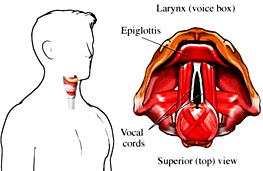A polyp
is a
growth
(usually
benign)
protruding
from a
mucous
membrane.
When
polyps
are seen
over
vocal
cords
they are
called
as vocal
polyps
or vocal
nodules.
Vocal
cords
are like
two
strings
present
in the
voice
box
(larynx)
and are
absolutely
essential
for
phonation.
Nodules
on the
vocal
cords
interfere
with
normal
voice
functioning
and
produce
a
hoarse,
breathy
or weak
voice.
|

|
|
Causes:
Vocal
nodules
develop
from
various
reasons
ranging
from
voice
overuse
(such as
prolonged
singing,
shouting
or loud
talking)
or
cigarette
smoke,
viral
infection,
or
chronic
inflammation
and
sinusitis.
Moreover,
it is
believed
that
polyps
or
nodules
are an
allergic
inflammatory
reaction.
Allergy
is an
altered
state of
normal
immunity
that
overreacts
to
otherwise
harmless
agents.
Symptoms:
The
commonest
symptom
of vocal
nodules
is
hoarseness.
The
voice
may also
sound
low-pitched
or
slightly
breathy.
Treatment:
Homeopathic
approach
towards
vocal
nodules
is more
totalistic
and
holistic.
Rather
than
considering
nodules
as a
local
problem,
they are
considered
to be an
affection
of the
constitution.
Moreover,
allergy
(which
lies at
the root
of this
problem)
is a
constitutional
problem
and
calls
for
constitutional
approach
for its
management.
Homeopathic
treatment
is based
on same
constitutional
approach
for
management
of any
disease.
Not only
does
Homeopathy
help in
resolving
the
nodules
that
have
already
formed,
it also
helps in
preventing
the
recurrence
of the
vocal
nodules.
Suggestion
about
homeopathic
treatment:
Homeopathy
has a
very
positive
role in
the
management
of vocal
polyps,
especially
when
they are
small in
size. In
case of
professionals
for whom
voice is
the only
thing
that
matters,
risk of
alteration
of voice
quality
as a
complication
of
surgery,
can be
very
serious.
Interestingly,
timely
administered
homeopathy
treatment
can help
avoid
surgery.
Remarks:
Voice
Therapy:
Correcting
the
vocal
pattern
that has
created
the
disorder
is very
essential
and here
comes
into
play the
voice
therapy.
This
mainly
includes
teaching
good
vocal
techniques
to the
patient
that can
reduce
the
amount
of
pressure
put on
the
vocal
cords. |
|
|
|
Click
here for Case
Studies |
|
|


















